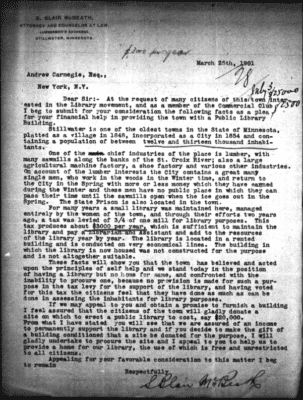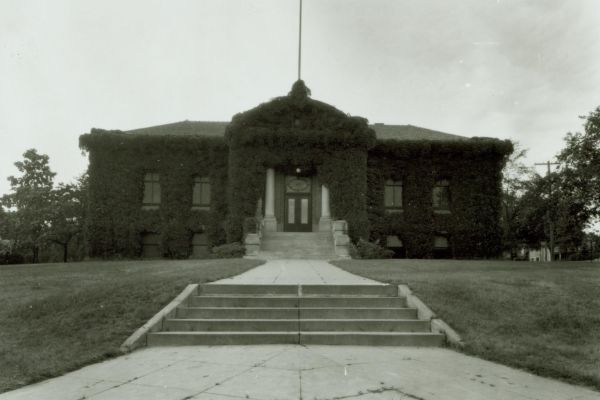More Than 125 Years of Service
Stillwater Public Library is a bridge from our history to the future. We evolve to meet changing needs while honoring our past and strengthening our legacy of public service.
1859: Library Services
The record of library services in Stillwater began on June 17, 1859, when a group of prominent local men voted to establish the Stillwater Library Association, eligible to receive federal documents, books, and other publications.
The association was not a public library as only members could access the collection. The library did not have a permanent home, instead moving frequently, from the office of city founder John McKusick to city council offices and even the city jail!
The graphic above includes a digitized image of the board minutes from the first meeting of the Stillwater Library Association and a photo of John McKusick, one of the founding members of the Association.
1869: Lending Library
The limitations of the association prompted a group of local women to form the city’s first lending library. This “ladies’ library” relied on subscription fees, charging $1.00 for men and $0.50 for women.
The “ladies’ library” soon merged with the association and was incorporated as the (new) Stillwater Library Association, opening on November 1, 1869. The association was still not a public library and only members could rent books.
The collection was first housed in Mr. S.S. Denton’s store, near Main and Myrtle, with Carrie Denton, Mr. Denton’s daughter, serving as the librarian. For the next five years or so, the library’s collection was hosted, free of charge, within local businesses, while the business’s proprietor acted as the librarian. The collection was housed variously in a drug store, a music stand, a sewing machine shop, and pictured above, a millinery shop in the Mower block at Second and Chestnut (the shorter building on the right).
1897: Free Library
In 1897, the association’s ongoing funding challenges prompted it to join a larger nationwide movement that sought to establish libraries which were supported by public funding, rather than subscriptions. These so-called “free libraries” also expanded access by providing services to those who could not afford to pay subscription fees.
Stillwater’s first free public library was established by referendum in November 1897. The library continued to be housed in the Jassoy Building at Third and Chestnut, pictured above and still standing.
An important issue that faced the new organization was whether the women who had worked so tirelessly for the referendum’s passage could be appointed to the library board. Women in Minnesota could not hold elective office at that time. The question was decided in the affirmative, and all board members were women until 1982.
1901: Carnegie Grant
As a public library, Stillwater Public Library was supported by city taxes and was open free of charge to all residents. After decades of renting space, the library needed a permanent home and room to grow. Fortunately, the library’s need for a new home coincided with a major philanthropic effort by retired steel magnate Andrew Carnegie (pictured above) to build public libraries across the country.
In 1901, Carnegie offered $25,000 to provide funds for the construction of the building if the city provided land for the site and $2,500 annually for the library’s operation. The city agreed to the plan. By 1903, Carnegie donated a total of $27,500 to build the library.

1902: Library Built
The first Carnegie funds arrived in October 1902. The cornerstone of the new building was laid on November 13, 1902, on the Bean-Harrigan site, a “retired and quiet” location above the fray of downtown. A little over a year later, on December 15, 1903, the Beaux Arts building, designed by Patton and Miller, opened to the public.
The above bird’s-eye photo, believed to be from 1904, shows a view of the new library soon after its completion. The below photos show the library from the Fourth Street side (top) and Third Street side (bottom).


1952: 50th Anniversary
Pictured is the library’s main desk with the book stacks visible behind. From left to right are Mrs. Arthur Johnson, a library patron; Lilly Carlson, library assistant; and Gertrude Glennon, head librarian. The photo is from 1952 when the library had its 50th anniversary.
The library supported the Stillwater community through two world wars, the Depression, and into the post-war era. Although the population of Stillwater dwindled during this period, the library remained vibrant. Children’s story hour and summer reading programs started during this time.
During the Depression, the library reading rooms were filled with the unemployed and circulation set new records. During World War II, the library expanded its nonfiction collections to cover the Pacific, Asia, and Europe to provide information about the theaters of war. Once the soldiers returned, the library increased its emphasis on adult education.
1973: Two New Wings
By the early 1970s, the library needed more space. In 1972, a $400,000 grant from the Margaret Rivers Fund, an endowment created by lumberman Robert E. Slaughter in memory of his mother, allowed the library to add a north and south wing to the original library building, doubling the floor space. The renovated building opened in 1973.
From the exterior, few viewers could distinguish where the original building ended and the additions — designed by Ackerman and Associates — began. The space allowed the expansion of the nonfiction collection and the addition of audiovisual materials.
1987: Reconfiguration
In 1986-87, the library renovated the building and reconfigured 2,000 square feet of nonpublic space to public areas, adding handicapped accessiblity, energy efficiency, and flexibility. The renovation earned a library building award from the American Institute of Architects and the American Library Association.
At this time, reference service was enhanced and emphasized. The card catalog was replaced by a computer catalog in 1989. The library then automated all of its essential operations to provide better inventory control and new patron services.
2006: Expansion
In 2006, the library grew again. A major expansion added 19,000 square feet to the east of and underneath the library bringing the library building to where it is today.
Funded by a public-private partnership that demonstrated the generosity of the community and its love for its library, the expansion both preserved and enhanced the Carnegie structure. The project added the spaces and facilities needed for a modern library while keeping the historic part of the building intact and incorporating design elements from the 1902 building. The renovation and addition included a parking ramp and new lower level for the children’s area, teen area, and nonfiction. It retained the historic upper level and rotunda while adding valuable community space with meeting rooms, a gallery, and an outdoor terrace.
For more information about our history, visit the library display on the Mezzanine Level, located in the antique bookcase just past the spiral staircase.

